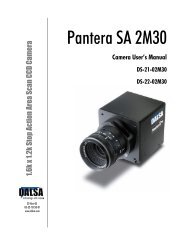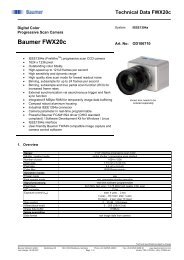TR-33 TR-34 TR-35 Trillium Rhino User's Manual - Frame Grabbers
TR-33 TR-34 TR-35 Trillium Rhino User's Manual - Frame Grabbers
TR-33 TR-34 TR-35 Trillium Rhino User's Manual - Frame Grabbers
You also want an ePaper? Increase the reach of your titles
YUMPU automatically turns print PDFs into web optimized ePapers that Google loves.
<strong>Trillium</strong> User’s <strong>Manual</strong> 27<br />
and the dark calibration must be repeated if the camera temperature varies more<br />
than 10 C °.<br />
To perform dark calibration:<br />
1. Stop all light from entering the camera.<br />
2. Issue the command correction_calibrate 1. The camera will respond<br />
with Ok> if no error occurs.<br />
3. After the calibration is complete, you can save these settings to non-volatile<br />
memory so they will be remembered after power-down. To do so, issue the<br />
command write_settings.<br />
White Light Calibration<br />
White light calibration is more complex than dark calibration because the camera<br />
attempts to create a flat white image. This calibration corrects PRNU effects as<br />
well as non-uniform lighting and lens vignetting affects.<br />
White light calibration requires a clean, white reference. The quality of this<br />
reference is important for proper calibration. White paper is often not sufficient<br />
because the grain in the white paper will distort the correction. A more uniform<br />
source such as white plastic will lead to better balancing.<br />
The factory default balance target is 94% for all channels. This means that the<br />
white light calibration algorithm will ensure that for the white reference, the<br />
resulting image will have all pixels set to 94% of saturation (~240DN) after<br />
removing random noise. Balance targets can also be set independently for each<br />
channel. See page 29.<br />
Note: If your<br />
illumination or<br />
white reference<br />
does not extend<br />
the full field of<br />
view of the<br />
camera,<br />
calibration will<br />
still be successful<br />
for the center<br />
portion of the<br />
image. However,<br />
the camera will<br />
send a warning<br />
that the<br />
illumination level<br />
is too low under<br />
these conditions.<br />
There are several restrictions that must be met in order for the calibration to<br />
succeed. Our testing has shown that these criteria can be easily met with a<br />
halogen bulb light source (one bulb for 1k resolution; two for 2k) and a fiberoptic<br />
light pipe.<br />
1. At high gain settings, the camera is sufficiently sensitive to detect 60 Hz<br />
ambient light flicker which may affect camera performance and calibration<br />
results.<br />
2. The light must be bright enough (within the 4:1 range available) so the<br />
camera can reach the balance. If the light is not bright enough, then the<br />
camera will not produce a flat response to a white surface and the resulting<br />
image will be gray.<br />
3. The light must not be too bright (within the 4:1 range available) for the<br />
camera to reach the balance. If the camera is at minimum gain and the image<br />
sensor is still saturated, the calibration can not be completed.<br />
DALSA 03-32-10119-03
















